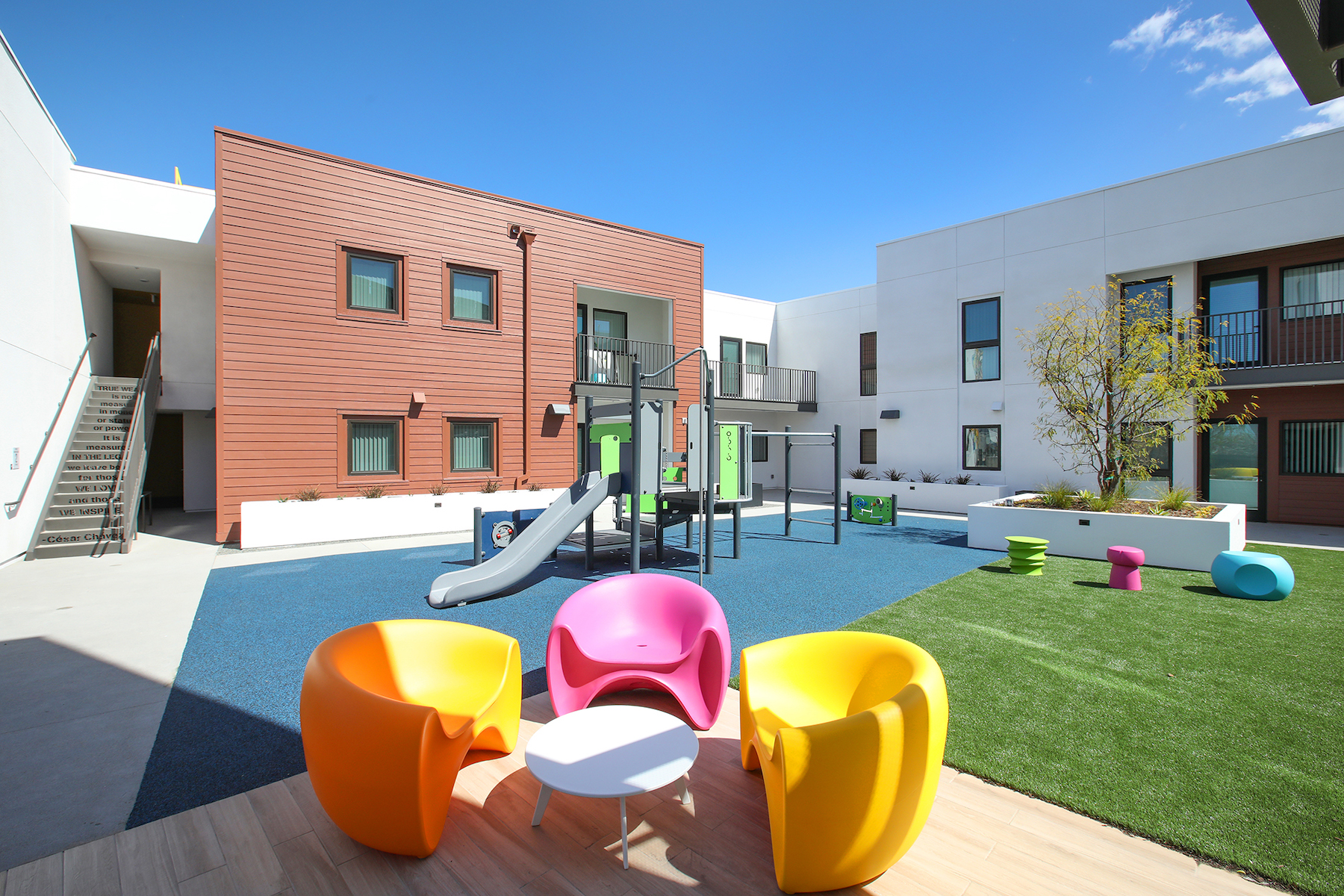According to one estimate, America’s cities and suburbs are host to some 70,000 strip malls, many of which are riddled with vacant stores and shuttered gas stations. Could not these outmoded neighborhood malls be put to better use, possibly for much-needed affordable housing? That question became more than a hypothetical for the project team for La Placita Cinco, in the Southern California city of Santa Ana.
If you’ve ever flown into John Wayne Airport, you’ve at least touched down in Santa Ana. Its 310,227 residents account for a tenth of Orange County’s population. Three-quarters of its residents (76%) identify as Hispanic or Latino; 43% are foreign-born. Median household income was $72,406 in 2020, versus $94,441 for the county. A chronic shortage of affordable housing has led to widespread overcrowding in the city. “Our families are doubled- and tripled-up,” said Judson Brown, Santa Ana’s Housing Manager.
Sometime in the 1970s, Tiny Tim Plaza (no one can recall how it got its curious name), a 2.33-acre shopping center featuring a gas station and two intersecting rows of retail businesses, opened in Santa Ana’s Artesia Pilar neighborhood. For decades, local residents loyally patronized its dozen or so shops, which included a bakery, a grocery store, a butcher shop, a restaurant, a coffee shop, a locksmith, a beauty salon, a clothing store, a homeopathic therapy store, an electronics shop, an insurance office, and a laundromat.
In 2016, Brian Hendricks, Principal with local real estate firm Magis Realty, bought the property with the intent of razing the site and building studio and one-bedroom apartments. That scheme was stymied when the laundromat owner, whose lease ran till 2038, held out for a Midas-sized pile of cash. Hendricks then linked up with Community Development Partners, a well-respected Southern California nonprofit developer founded in 2011 by brothers Kyle and Eric Paine, to help break the deadlock and redevelop the property for housing.
STARTING OVER FROM SCRATCH
The holdout forced CDP to rethink the whole scheme. Should they keep the shops, which were chugging along, despite their age? And could they recalibrate the unit mix to provide larger, more family-oriented apartments to help overcome Santa Ana’s monumental housing shortage, and help the city meet its numbers under the state’s Regional Housing Needs Allocation system? Studio and one-bedroom units, said Brown, “were not what the city needed.”
“From the city’s perspective, our goal was clear: to help the developer realize a project that would balance affordable housing and reinvestment in the commercial shopping district in a manner that would serve the community’s diverse needs,” said Ali Pezeshkpour, AICP, Principal Planner for the city. It helped that the site was within walking distance of not one but two stations of a planned extension of the Orange County light-rail line. “That was the cherry on top,” said Brown.
CDP subsequently bought out Magis’s share of the property and brought in Integrity Housing as finance consultant; Mercy House as service provider; City Fabrick, a nonprofit urban design studio, as designer; and TCA Architects as executive architect.
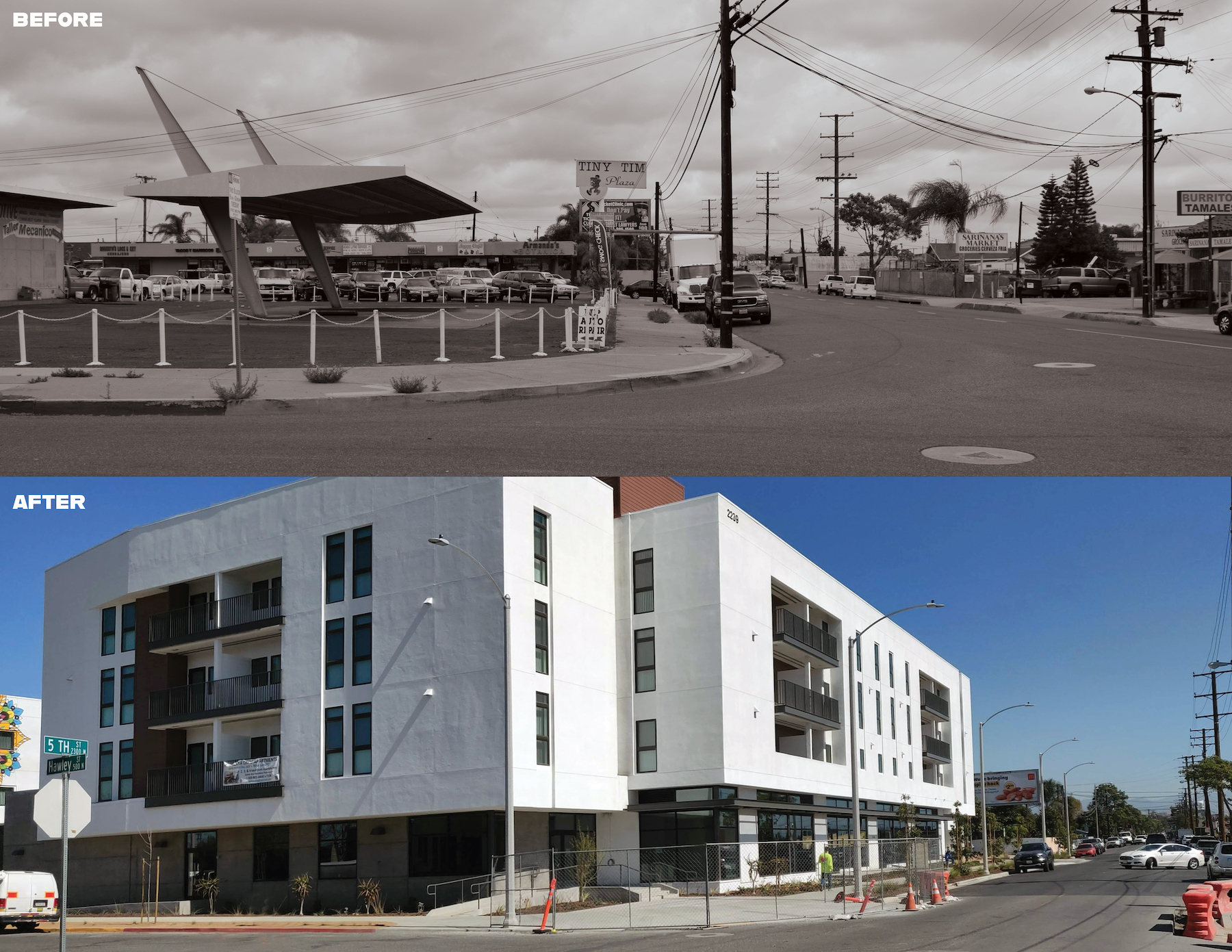
Coincidentally, City Fabrick had just participated in a competition to study how garden-variety strip centers like Tiny Tim could be converted into more intense, pedestrian-oriented community assets. “We didn’t win, but we amassed a lot of knowledge about what worked and what didn’t,” said Brian Ulaszewski, LEED AP, City Fabrick’s Executive Director.
That knowledge would soon be put to the test in more than a year of meetings with stakeholders.
SECURING THE ENTITLEMENTS
Before any housing could be built, the property had to be rezoned from commercial to mixed-use. But when word got out that such a rezoning would allow “affordable” housing, homeowners in the adjacent single-family neighborhood started asking questions: Did “affordable” really mean “cheap”? Would their quality of life be affected? Would their property values be negatively affected?
From a design standpoint, the key sticking point had to do with the height of the structure. “We started with a shorter building, but the city wanted us to break the scale of the development down as you go into the neighborhood, which resulted in more variety in building height,” said Ulaszewski.
After a year of discussion with the city and surrounding neighborhood, the rezoning was granted. This discussion resulted in a podium-style structure—Tim Mustard, AIA, Principal, TCA Architects, calls it a “floating box”—that surrounds a central courtyard. The four-story urban edge, on 5th Street, steps down to three stories toward the single-family homes and the retail buildings.
La Placita Cinco opened in 2021 with 20 two-bedroom, 29 three-bedroom, and two four-bedroom apartments. CDP added the two large units even though they were not required. “CDP always tries to go above the minimum, which helps them navigate through the approval process,” said Mustard. Fifteen units were devoted to families earning 30% of Orange County’s AMI, five for families at 50% of AMI, and 30 for families at 60% of AMI. (One unit was set aside for the property manager.) Monthly rents range from $1,632 to $2,154.
Unlike most new or redeveloped apartment projects, where the developer sets aside ground-floor space in the hope of attracting retail tenants, Tiny Tim Plaza was fully occupied. “It was like a little town square,” said Ulaszewski. “You couldn’t curate all those commercial uses from scratch. It just needed some help to pull it all together.”
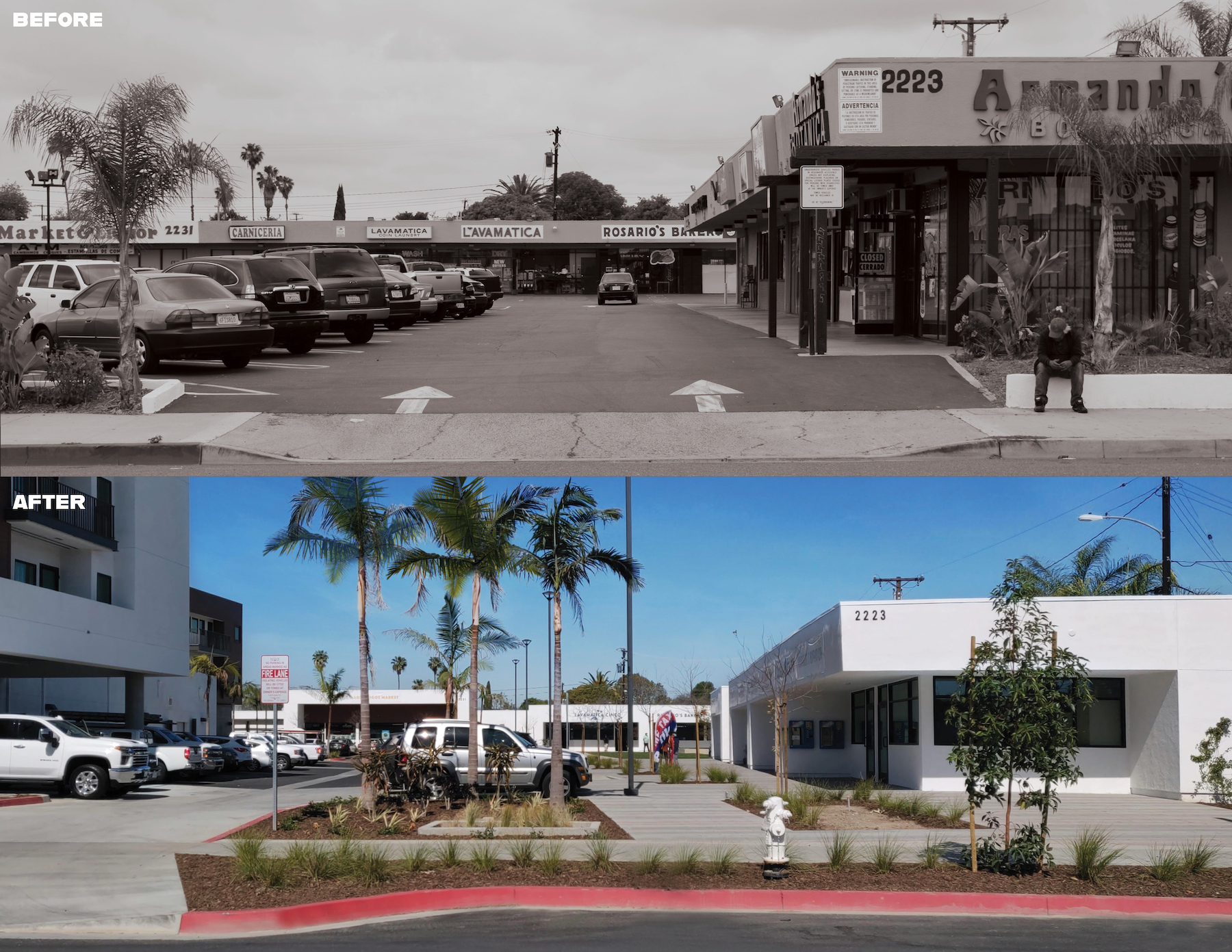
“The neighbors told us there had been no investment in the shopping plaza in more than 40 years,” said CDP’s President, Kyle Paine. “They cared about it, but they wanted to see investment that would benefit them.”
REINVIGORATING THE SHOPPING EXPERIENCE
The storefronts showed their age—“heavy stucco awnings with no identity, really monotonous,” said Ulaszewski. A grant from the Wells Fargo Foundation enabled the project team to work with the shop owners to modernize the façades of their stores. “The survival of the businesses was incredibly important, especially during the Covid pandemic, and Wells Fargo really made a significant positive impact there,” said Pezeshkpour.
Other improvements included new outdoor lighting, widened sidewalks to enhance pedestrian access, upgrades to the stores’ mechanical systems, and a new cool roof. The asphalt in the parking lot was replaced with permeable paving, and a 36,700-sf natural turf mini-park was added to further upgrade the property.
To support the businesses, CDP pledged to keep their rents flat for three years, then cut their rents in half during construction. When the pandemic hit, CDP stopped charging them rent altogether.
Today, with a lone exception all of the businesses are still in operation and “doing even better than before,” said Ulaszewski.
Artesia Pilar residents also raised concerns about parking at La Placita Cinco. Would there be enough dedicated spaces for all tenants, or would their cars spill over onto their already crowded streets?
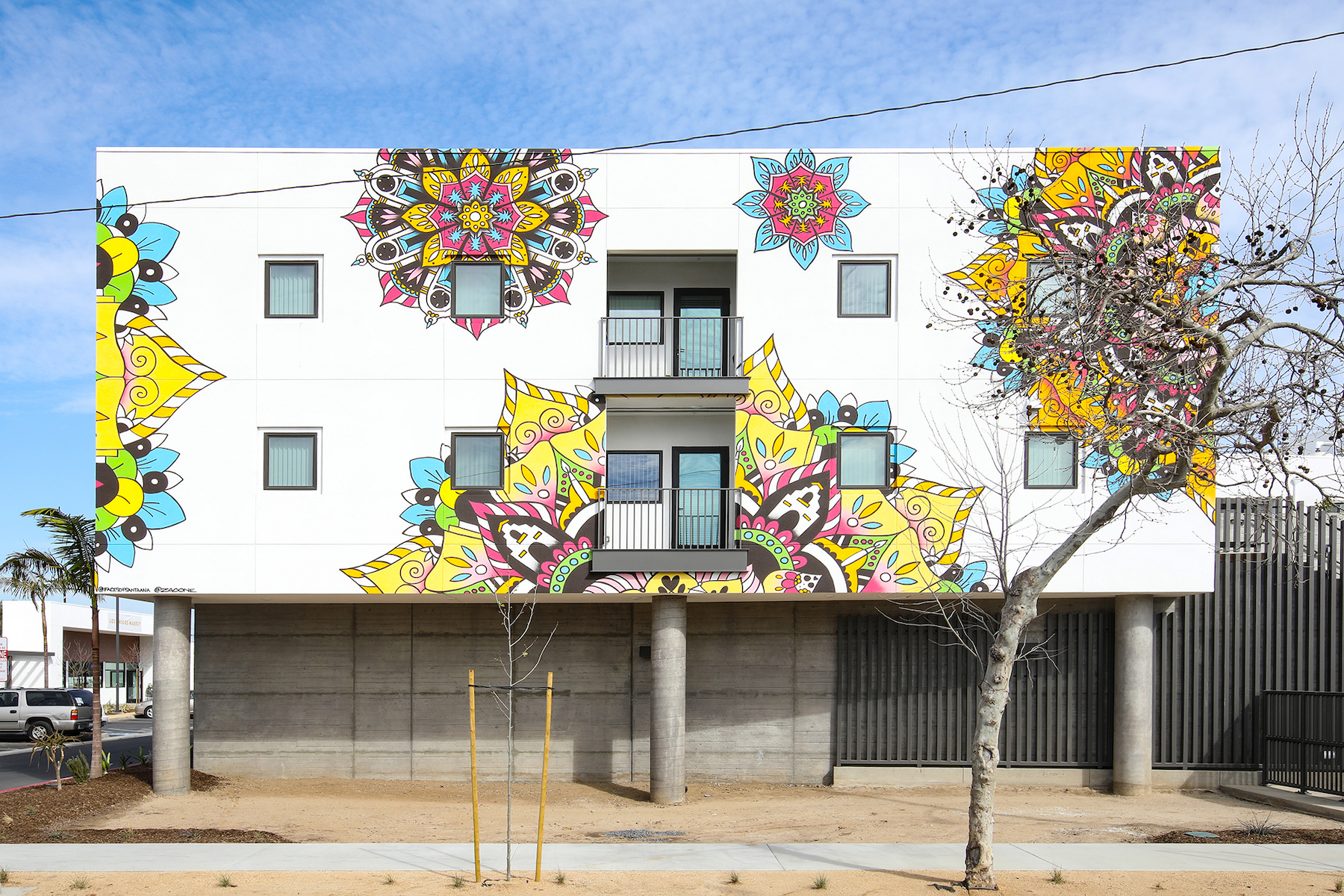
The project team toyed with the idea of building a parking structure, but quickly dismissed it as too expensive. They tried a split-level podium and other configurations, none of which worked.
In the end, they designed a podium structure that was high enough to accept car lifts to stack tenants’ cars one on top of the other. This created 91 residential parking stalls, or 1.75 spaces/unit, well above the 1.25 spaces/unit required by state law. This solution also meant that less contaminated soil under the old gas station was disturbed. “That saved a lot on remediation costs,” said TCA’S Mustard. Another 57 surface spaces serve the retail stores.
COMING UP WITH THE DOLLARS
Community Development Partners had to dip into multiple pots to raise the $31.4 million for La Placita Cinco. Because the site was on a planned streetcar line, the city helped CDP apply to California’s Affordable Housing and Sustainable Communities program, which funds transit-oriented developments. (See “We need more ‘TOD’ housing,” https://bit.ly/3trylN2). “It was a very competitive round, and they just missed getting the grant,” said Brown.
ALSO SEE: 7 tips for designing fitness studios in multifamily housing developments
Luckily, CDP was on the waiting list for a 9% federal LIHTC award when, “by the skin of their teeth, they qualified,” said Brown. The city added a $6 million grant from its inclusionary housing fund. “The $6 million really kickstarted the deal,” said CDP’s Kyle Paine. Citibank provided construction financing, Freddie Mac covered the long-term debt, and R4 Capital administered the equity tax credits.
TAKE A SECOND LOOK TO SEE ALL THE POSSIBILITIES
“In the 1970s, when strip malls were being born, we had an automobile-centric mentality,” said TCA’s Mustard. “Now it’s a pedestrian-centric environment. We need developers to get out of any preconceived notions about what to do with a site, and, with a little more thought, come up with a really good community project.”
Santa Ana’s Pezeshkpour echoed that sentiment. “As we look at our cities, the easiest parcels to redevelop are the vacant lots, but we should be looking at what’s possible on these underdeveloped commercial sites and use that space more efficiently and wisely to better meet the needs of our communities.”
La Placita Cinco is proof of that concept. Last October, the project won the Jack Kemp Award for Excellence in Affordable and Workforce Housing from the Urban Land Institute.

MEETING RESIDENTS’ NEEDS AT LA PLACITA CINCO
“We provide services that many of our residents never had before,” said Stephanie Medina, Residential Services Coordinator with Mercy House, the nonprofit social services agency at La Placita Cinco.
“During the pandemic, as residents started moving in, some families were struggling with rent due their wages being cut, or their hours reduced. Or they had to leave their jobs to take care of their children,” said Medina. “We helped them get rental assistance.”
Medina, who grew up in Santa Ana and is bilingual, translates documents for residents, such as job applications, rental and utility assistance forms, and information about local programs and resources.
On the first floor of the community center, residents have access to computers, printers, Internet access, foosball and Ping Pong tables, as well as a fully stocked art studio. The second floor has a tenants-only space for parties and events, plus a children’s playground. “The parents feel their kids are safe here,” said Medina.
Building Team Information for La Placita Cinco, Santa Ana, Calif.
Owner/developer: Community Development Partners
Financial consultant: Integrity Housing
Design studio: City Fabrick
Executive architect: TCA Architects
Structural engineer: Harris & Sloan
Civil engineer: Ware Malcomb
Mechanical engineer: LDI Mechanical
Electrical engineer: Salas O’brien
Plumbing engineer: AMPAM Parks Mechanical
Social services: Mercy House
Property manager: FPI Management
General contractor: Walton Construction


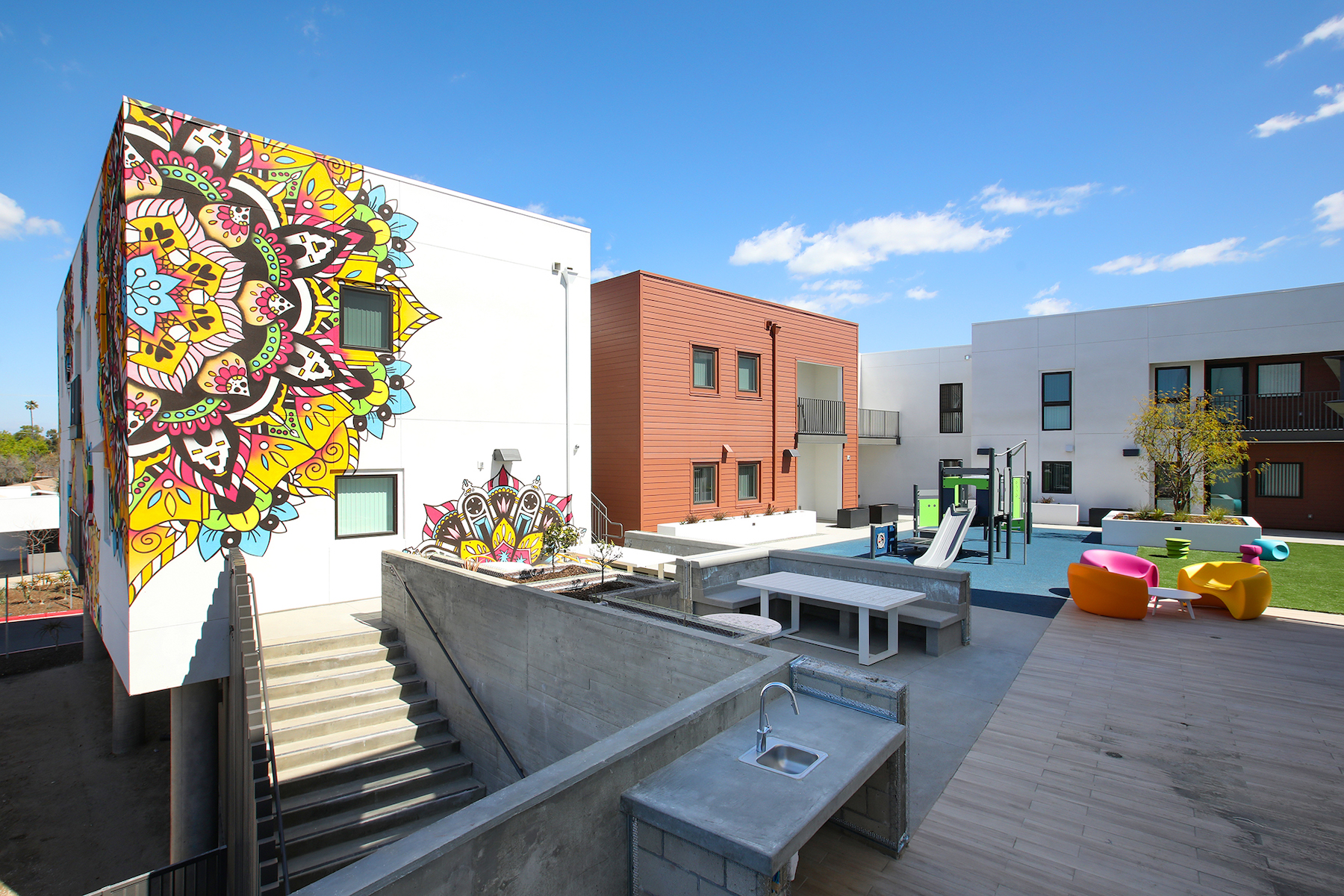
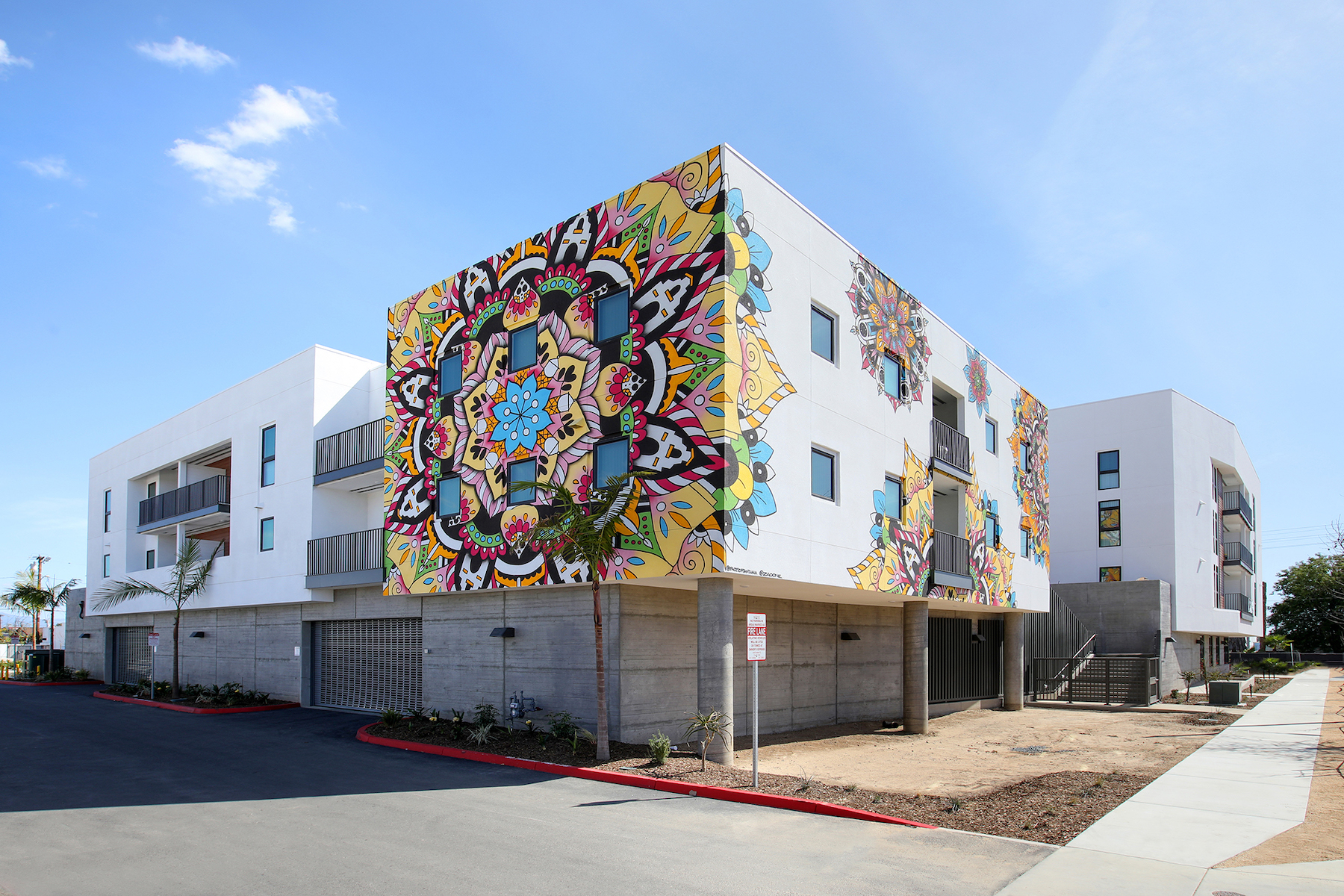
Related Stories
Student Housing | Mar 13, 2023
University of Oklahoma, Missouri S&T add storm-safe spaces in student housing buildings for tornado protection
More universities are incorporating reinforced rooms in student housing designs to provide an extra layer of protection for students. Storm shelters have been included in recent KWK Architects-designed university projects in the Great Plains where there is a high incidence of tornadoes. Projects include Headington and Dunham Residential Colleges at the University of Oklahoma and the University Commons residential complex at Missouri S&T.
Mixed-Use | Mar 11, 2023
Austin mixed-use development will provide two million sf of office, retail, and residential space
In Austin, Texas, the seven-building East Riverside Gateway complex will provide a mixed-use community next to the city’s planned Blue Line light rail, which will connect the Austin Bergstrom International Airport with downtown Austin. Planned and designed by Steinberg Hart, the development will include over 2 million sf of office, retail, and residential space, as well as amenities, such as a large park, that are intended to draw tech workers and young families.
Multifamily Housing | Mar 7, 2023
Multifamily housing development in Chicago takes design inspiration from patchwork and quilting
HUB 32, a 65-unit multifamily housing development, will provide affordable housing and community amenities in Chicago’s Garfield Park neighborhood. Brooks + Scarpa’s recently unveiled design takes inspiration from the American tradition of patchwork and quilting.
Adaptive Reuse | Mar 5, 2023
Pittsburgh offers funds for office-to-residential conversions
The City of Pittsburgh’s redevelopment agency is accepting applications for funding from developers on projects to convert office buildings into affordable housing. The city’s goals are to improve downtown vitality, make better use of underutilized and vacant commercial office space, and alleviate a housing shortage.
Student Housing | Mar 5, 2023
Calif. governor Gavin Newsom seeks to reform environmental law used to block student housing
California Gov. Gavin Newsom wants to reform a landmark state environmental law that he says was weaponized by wealthy homeowners to block badly needed housing for students at the University of California, Berkeley.
Green Renovation | Mar 5, 2023
Dept. of Energy offers $22 million for energy efficiency and building electrification upgrades
The Buildings Upgrade Prize (Buildings UP) sponsored by the U.S. Department of Energy is offering more than $22 million in cash prizes and technical assistance to teams across America. Prize recipients will be selected based on their ideas to accelerate widespread, equitable energy efficiency and building electrification upgrades.
AEC Innovators | Mar 3, 2023
Meet BD+C's 2023 AEC Innovators
More than ever, AEC firms and their suppliers are wedding innovation with corporate responsibility. How they are addressing climate change usually gets the headlines. But as the following articles in our AEC Innovators package chronicle, companies are attempting to make an impact as well on the integrity of their supply chains, the reduction of construction waste, and answering calls for more affordable housing and homeless shelters. As often as not, these companies are partnering with municipalities and nonprofit interest groups to help guide their production.
Modular Building | Mar 3, 2023
Pallet Shelter is fighting homelessness, one person and modular pod at a time
Everett, Wash.-based Pallet Inc. helped the City of Burlington, Vt., turn a municipal parking lot into an emergency shelter community, complete with 30 modular “sleeping cabins” for the homeless.
Multifamily Housing | Mar 1, 2023
Multifamily construction startup Cassette takes a different approach to modular building
Prefabricated modular design and construction have made notable inroads into such sectors as industrial, residential, hospitality and, more recently, office and healthcare. But Dafna Kaplan thinks that what’s held back the modular building industry from even greater market penetration has been suppliers’ insistence that they do everything: design, manufacture, logistics, land prep, assembly, even onsite construction. Kaplan is CEO and Founder of Cassette, a Los Angeles-based modular building startup.
Seismic Design | Feb 27, 2023
Turkey earthquakes provide lessons for California
Two recent deadly earthquakes in Turkey and Syria offer lessons regarding construction practices and codes for California. Lax building standards were blamed for much of the devastation, including well over 35,000 dead and countless building collapses.


